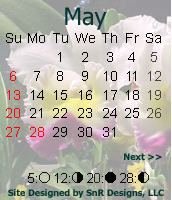
Gardening | Landscaping
| Swimming Pools
Here in Ahwatukee we love the outdoors. If doesn't matter what time of year it is, we'll find something
to do outside, it's one of the most important reasons we live in Arizona! In this section of the site,
we will offer information about Gardening, Landscaping and Pools. Our gardening section also features
information from Summer Winds Nursery. Summer Winds is located in Tempe and is one of our closer nurseries.
FAQ's
Can I grow flower bulbs here in the valley?
Yes you can try the following:
Tulips, Daffodils, Dutch Iris, Crocus, Hyacinth, with a little bit of care used in planting.
Adding a teaspoon or two of bone meal in the hole when planting helps also.
Pre-chilling for Tulips, Crocus, and Hyacinths is needed. Four to six weeks in the fridge -not the freezer,
for great spring flowers.
Garden Tips
Winter
Frost Damage
Frost can damage flowers, trees and shrubs. If you have exprienced frost damage, wait to prune the damaged foliage until mid
February as the weather warms up for the spring season. Remember that Bougainvillea, Hibiscus, and Lantana are all frost sensitive and
care for them accordingly. Do make sure your plants do not dry out during the winter and maintain the
proper moisture that each plant requires.
Summer
If you haven't already done it, remember to:
1. Remember to fertilize roses once a month.
2. Paint citrus trunks to prevent sunburn in the summer.
3. Fertilize annuals, perennials, trees, vegetables and lawns.
Shrubs add interesting colors and textures to your potted gardens.
Potted gardens offer a wonderful opportunity to change the look of a garden
and add a splash of color. But itís easy to fall into a rut and end up
planting the same perennials year after year. Consider shrubs. Many
varieties do well in containers, and allow for some creativity.
Roses
Pruning:
You can prune roses anytime from the end of December through January.
Summer:
Fertilize monthly with a rose food, prune out dead branches, ugly canes and dead branch tips.
New growth will appear lush and green soon. Stop fertilizing in December.
Did you know?
It really is getting hotter across the United States. The National Arbor Day Foundation has a new and
revised Hardiness Zone to account for the climatic shifts of the past decade. The USDA Hardiness Zone map is the standard
reference for defining plant hardiness. The map was updated in the 90's to account for shifts, however the climate has
continued to get warmer.
It is still a 10-zone map and those zones still incorporate the same temperatures. What changes is the geographical coverage
of each zone. This has caused the range of each zone to shift north.
To view the new zones, click below:
Arbor Day Zone Map
To view the Arbor Day Foundation site, click below:
National Arbor Day Foundation
Did you know?
An average tree reduces greenhouse gas concentrations by absorbing 26 pounds of carbon dioxide and turning it into
life-giving oxygen every year!
|



























